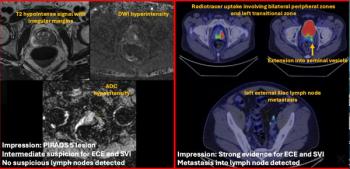
IV Contrast Safe for Neonates with Normal Renal System
MRI and CT with contrast provide no greater risk of toxicity for neonates with normal renal system.
Intravenous contrast for MR imaging provides no greater risk of toxicity for neonates with no known renal failure than does imaging with no contrast, according to a study published in
Researchers from the Perelman School of Medicine at the University of Pennsylvania in Philadelphia and Huntington Memorial Hospital in Pasadena, CA, performed a retrospective review of 280 neonates, aged younger than 30 days, who had undergone MR imaging or CT. Measures of renal function were obtained before the imaging and again after administration of the contrast material. Fifty-nine neonates underwent CT with iohexol or iodixanol and 81 who underwent MR imaging with gadopentetate dimeglumine. These neonates were frequency matched according to sex, gestational and postnatal age, and preimaging serum Cr levels with 140 neonates who underwent unenhanced MR imaging or CT.
The researchers grouped Cr levels and glomerular filtration rates (GFRs) according to when they were obtained:
• Before imaging
• 1–2 days after imaging
• 3–5 days after imaging
• 6–9 days after imaging
• 10–45 days after imaging
• More than 45 days after imaging.
The results showed that Cr levels decreased and GFRs increased in both groups from before to after imaging. Those who underwent contrast material–enhanced imaging and the neonates who underwent unenhanced imaging showed similar serum Cr levels at all examined time periods. The groups also did not differ in the proportion of neonates with serum Cr levels higher than the reference range (>0.4 mg/dL) at any time. Similar findings were observed for GFRs. None of the neonates developed nephrogenic systemic fibrosis.
The researchers concluded that neonates with normal renal function were not at risk for complications from intravenous iodine- and gadolinium-based contrast material.
Newsletter
Stay at the forefront of radiology with the Diagnostic Imaging newsletter, delivering the latest news, clinical insights, and imaging advancements for today’s radiologists.




























